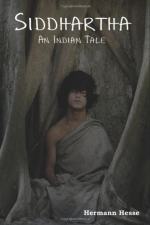|
This section contains 5,954 words (approx. 20 pages at 300 words per page) |

|
SOURCE: “Ticino Legends of Saints and Sinners,” in Hermann Hesse's Fictions of the Self: Autobiography and the Confessional Imagination, Princeton University Press, 1988, pp. 173–87.
In the following excerpt, Stelzig discusses Siddhartha in terms of authobiography, biography, life and art, and the subjectivity evident in modern literature.
Siddhartha
Hesse began his “Indian legend”1 in the winter of 1920; the writing proceeded rapidly, and by spring, he was halfway through Part 2, when he bogged down in the “By the River” chapter. For a time it seemed that the book would be consigned to his collection of unfinished works, but after a painful hiatus of nearly two years, he tackled it anew, and by May 1922 Siddhartha was finished. What had been the obstacle? One explanation is that Hesse, like many artists, experienced a letdown after a spell of intensive work, for, as he laments in the journal he kept to fill the void...
|
This section contains 5,954 words (approx. 20 pages at 300 words per page) |

|


